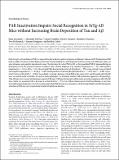| dc.contributor.author | Tonegawa, Susumu | |
| dc.contributor.author | Arsenault, Dany | |
| dc.contributor.author | Dal-Pan, Alexandre | |
| dc.contributor.author | Tremblay, Cyntia | |
| dc.contributor.author | Bennett, David A. | |
| dc.contributor.author | Guitton, Matthieu J. | |
| dc.contributor.author | De Koninck, Yves | |
| dc.contributor.author | Calon, Frederic | |
| dc.date.accessioned | 2014-02-28T14:11:40Z | |
| dc.date.available | 2014-02-28T14:11:40Z | |
| dc.date.issued | 2013-06 | |
| dc.date.submitted | 2013-05 | |
| dc.identifier.issn | 0270-6474 | |
| dc.identifier.issn | 1529-2401 | |
| dc.identifier.uri | http://hdl.handle.net/1721.1/85179 | |
| dc.description.abstract | Defects in p21-activated kinase (PAK) are suspected to play a role in cognitive symptoms of Alzheimer's disease (AD). Dysfunction in PAK leads to cofilin activation, drebrin displacement from its actin-binding site, actin depolymerization/severing, and, ultimately, defects in spine dynamics and cognitive impairment in mice. To determine the role of PAK in AD, we first quantified PAK by immunoblotting in homogenates from the parietal neocortex of subjects with a clinical diagnosis of no cognitive impairment (n = 12), mild cognitive impairment (n = 12), or AD (n = 12). A loss of total PAK, detected in the cortex of AD patients (−39% versus controls), was correlated with cognitive impairment (r[superscript 2] = 0.148, p = 0.027) and deposition of total and phosphorylated tau (r[superscript 2] = 0.235 and r[superscript 2] = 0.206, respectively), but not with Aβ42 (r[superscript 2] = 0.056). Accordingly, we found a decrease of total PAK in the cortex of 12- and 20-month-old 3xTg-AD mice, an animal model of AD-like Aβ and tau neuropathologies. To determine whether PAK dysfunction aggravates AD phenotype, 3xTg-AD mice were crossed with dominant-negative PAK mice. PAK inactivation led to obliteration of social recognition in old 3xTg-AD mice, which was associated with a decrease in cortical drebrin (−25%), but without enhancement of Aβ/tau pathology or any clear electrophysiological signature. Overall, our data suggest that PAK decrease is a consequence of AD neuropathology and that therapeutic activation of PAK may exert symptomatic benefits on high brain function. | en_US |
| dc.language.iso | en_US | |
| dc.publisher | Society for Neuroscience | en_US |
| dc.relation.isversionof | http://dx.doi.org/10.1523/JNEUROSCI.1501-13.2013 | en_US |
| dc.rights | Article is made available in accordance with the publisher's policy and may be subject to US copyright law. Please refer to the publisher's site for terms of use. | en_US |
| dc.source | Society for Neuroscience | en_US |
| dc.title | PAK Inactivation Impairs Social Recognition in 3xTg-AD Mice without Increasing Brain Deposition of Tau and Aβ | en_US |
| dc.type | Article | en_US |
| dc.identifier.citation | Arsenault, D. et al. “PAK Inactivation Impairs Social Recognition in 3xTg-AD Mice without Increasing Brain Deposition of Tau and A.” Journal of Neuroscience 33.26 (2013): 10729–10740. | en_US |
| dc.contributor.department | Massachusetts Institute of Technology. Department of Biology | en_US |
| dc.contributor.mitauthor | Tonegawa, Susumu | en_US |
| dc.relation.journal | Journal of Neuroscience | en_US |
| dc.eprint.version | Final published version | en_US |
| dc.type.uri | http://purl.org/eprint/type/JournalArticle | en_US |
| eprint.status | http://purl.org/eprint/status/PeerReviewed | en_US |
| dspace.orderedauthors | Arsenault, D.; Dal-Pan, A.; Tremblay, C.; Bennett, D. A.; Guitton, M. J.; De Koninck, Y.; Tonegawa, S.; Calon, F. | en_US |
| dc.identifier.orcid | https://orcid.org/0000-0003-2839-8228 | |
| mit.license | PUBLISHER_POLICY | en_US |
| mit.metadata.status | Complete | |
